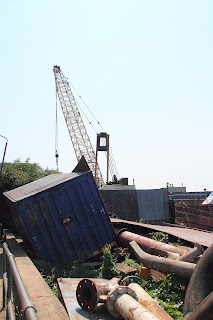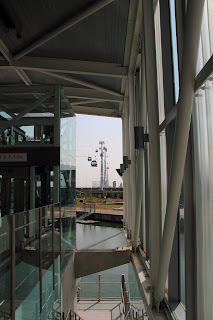The "Thames Path", is a wide and impressive sight in the west, with embankments, monuments, and riverside cafe's. A short ride on the Docklands Light Railway from Bank, reveals a completely different section of the path. Here in the centre of London's historic port area, the narrow dusty track picks its way between long abandoned wharves, old industry, and sparkling new redevelopment schemes. It is a world-apart from the London docks my grandparents grew-up in between the wars.
It was interesting to talk urban geography with the kids, and show them the different layers of London all around them. In some of the docks, old cranes have been left as cultural/historical monuments, but instead of the noise of ships, railways, trade, and bustling warehouses, the cranes add 'character' (and no doubt value) to the adjacent luxury apartments. The docks are not dead or dying a they once were, but these are presumably not homes for locals.
History, of course, is a complex business. Over-simplified versions of this story feature the families of the former dock-workers being priced out of their own neighbourhoods, while yuppies move into the new flats, and commute to the financial mecca's of the City of London and Canary Wharf. In my Grandparents case, WWII saw them driven from the area not by redevelopers, but by National Service, and evacuation from the threat of Hitler's bombers who devastated this part of the city. Life after the conflict was not resumed near the old family home by the London Docks, but in the less grimy new suburbs creeping westwards across Middlesex.
Little bits of the old docks still remain, quietly decaying.
The new cathedrals of mammon now dominate the landscape my Grandparents grew up with.
My favourite photo in this series - contrasting the two sides of London.
Redevelopment led by government (starting in the 80s) has focused on developing transport links, connecting the docks to the rest of London. The light railway, the airport, and the new cable-car ride across the Thames all connect the former port to the people and their money which drive the rest of the capital's economy.
The London Docklands: Old and New. Historic docks and wharves, late 20th Century apartments, and the new 'Air-Line'.

















No comments:
Post a Comment